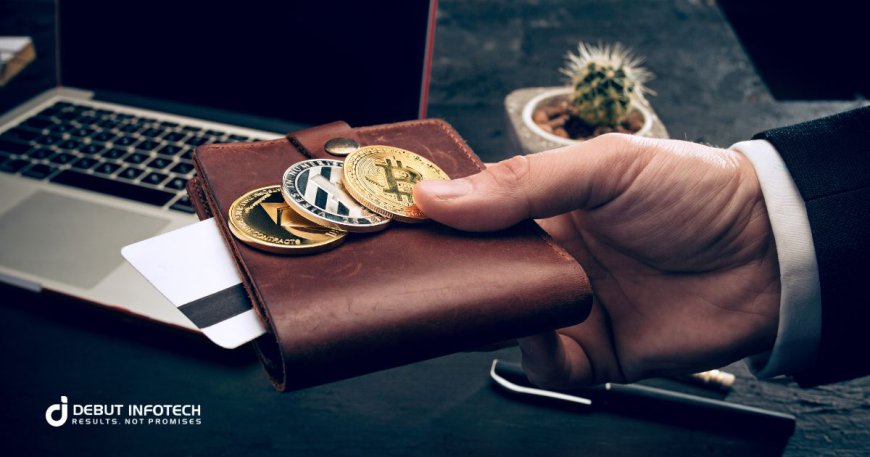Blockchain Wallet Development: A Comprehensive Guide to Secure and Efficient Digital Asset Management
Explore comprehensive blockchain wallet development services that ensure secure transactions, user-friendly interfaces, and multi-currency support tailored to your business needs

Introduction
As the world embraces the digital economy, cryptocurrencies and blockchain technology have become increasingly prevalent. One critical component of this digital landscape is the blockchain wallet, a tool that allows users to store, manage, and interact with their digital assets. Developing a secure and efficient blockchain wallet is crucial for anyone looking to participate in the cryptocurrency ecosystem. This micro-blog explores the importance of blockchain wallet development, the different types of wallets, and the steps involved in creating one.
What is a Blockchain Wallet?
A blockchain wallet is a software application that allows users to manage and store their cryptocurrencies securely. Unlike traditional wallets that hold physical currency, blockchain wallets store the cryptographic keys required to access a user’s digital assets on blockchain technology. These wallets enable users to send, receive, and monitor their cryptocurrency balances and transactions.
Types of Blockchain Wallets
There are several types of blockchain wallets, each offering varying levels of security and convenience. These include:
- Hot Wallets:
- Definition: Hot wallets are always connected to the internet, which makes them more convenient for frequent transactions but also more vulnerable to hacking.
- Use Case: Suitable for everyday transactions and active cryptocurrency traders.
- Examples: Mobile wallets, web wallets, desktop wallets.
- Cold Wallets:
- Definition: Cold wallets are offline wallets that provide an extra layer of security as they are not connected to the internet.
- Use Case: Ideal for long-term storage of large amounts of cryptocurrency.
- Examples: Hardware wallets, and paper wallets.
- Custodial Wallets:
- Definition: Custodial wallets are managed by third-party service providers who control the private keys on behalf of users.
- Use Case: Suitable for beginners or users who prioritize convenience over control.
- Examples: Wallets offered by exchanges like Binance, and Coinbase.
- Non-Custodial Wallets:
- Definition: Non-custodial wallets give users full control over their private keys, ensuring maximum ownership of their assets.
- Use Case: Suitable for experienced users who prefer complete control over their funds.
- Examples: MetaMask, Trust Wallet.
Key Features of a Blockchain Wallet
When developing a blockchain wallet, it’s essential to include features that ensure security, usability, and functionality. Some critical features include:
- Private and Public Key Management:
- Private Key: A secret key that allows the user to access and manage their cryptocurrency.
- Public Key: A public address where users can receive cryptocurrency.
- Effective management of these keys is crucial for the security of the wallet.
- Two-Factor Authentication (2FA):
- Adds an extra layer of security by requiring two forms of identification to access the wallet.
- Multi-Signature Support:
- Requires more than one private key to authorize a transaction, enhancing security, especially for institutional users.
- User-Friendly Interface:
- A simple and intuitive design is essential to make the wallet accessible to all users, regardless of their technical expertise.
- Backup and Recovery:
- Allows users to back up their wallets and recover them in case of device loss or theft.
Blockchain Wallet Development Process
Developing a blockchain wallet requires careful planning and execution to ensure security and functionality. Here is an outline of the typical development process:
- Define the Requirements:
- Determine the type of wallet (hot, cold, custodial, non-custodial) based on the target audience and their needs.
- Establish the core features, including security measures, user interface, and cross-platform compatibility.
- Choose a Blockchain Platform:
- Select a blockchain platform, such as Bitcoin, Ethereum, or Binance Smart Chain, based on the cryptocurrencies the wallet will support.
- Ensure that the chosen platform aligns with the wallet’s scalability and security requirements.
- Design the User Interface (UI):
- Focus on creating a user-friendly and visually appealing design that enhances the user experience.
- Keep the interface simple, allowing users to navigate easily and perform transactions without complications.
- Develop the Backend:
- Implement the core functionality, such as key management, transaction processing, and balance updates.
- Ensure robust encryption techniques are used to secure the private keys and user data.
- Integrate Blockchain APIs:
- Use blockchain APIs to interact with the blockchain network, enabling users to send, receive, and track their cryptocurrency transactions.
For more details, you can also check this blog on The Ultimate Guide To Blockchain Wallet Development.
Security Considerations for Blockchain Wallet Development
Security is the most critical aspect of blockchain wallet development. Developers must focus on safeguarding users' private keys, ensuring secure transactions, and protecting against cyberattacks. Some essential security considerations include:
- Encryption: Encrypt sensitive data, such as private keys and user information.
- Secure Key Storage: Use secure storage mechanisms, such as hardware security modules (HSMs), to protect private keys.
- Regular Audits: Conduct regular security audits to detect and fix vulnerabilities.
- Anti-Phishing Measures: Implement anti-phishing technologies to prevent users from falling victim to scams.
Conclusion
Blockchain wallet development is a critical component of the cryptocurrency ecosystem, offering users a secure and efficient way to manage their digital assets. By focusing on security, user experience, and functionality, developers can create blockchain wallets that meet the needs of a diverse range of users, from beginners to advanced traders.
